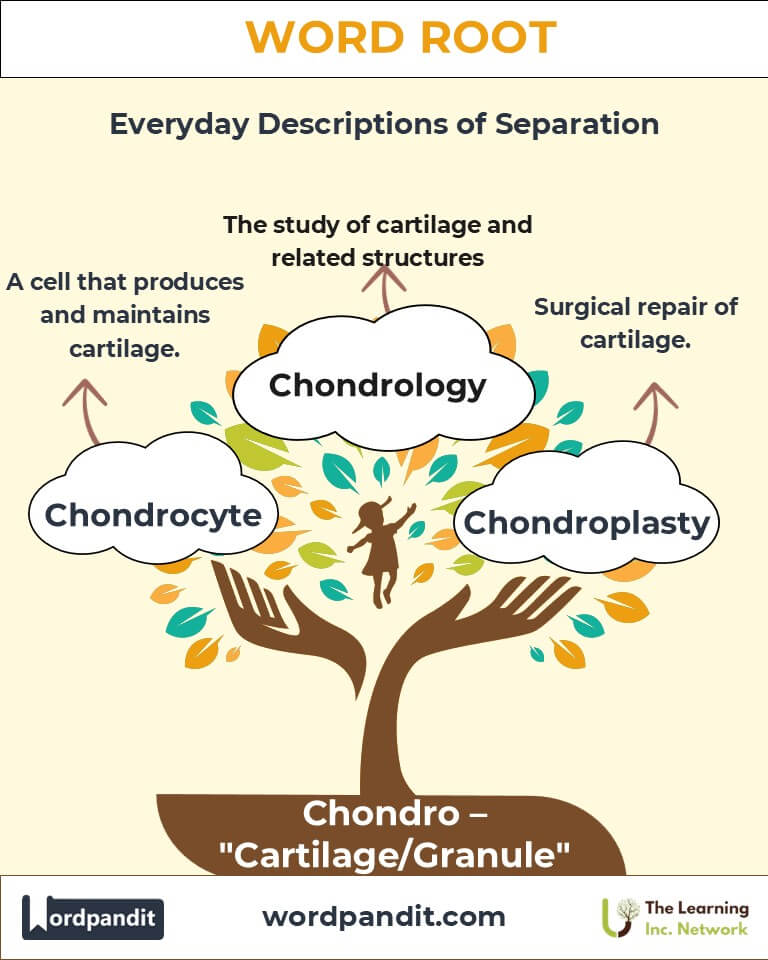Chondro: The Root of Cartilage and Cellular Structure
Byline:
Discover the fascinating role of the root "Chondro/Chondri," derived from Greek, meaning "cartilage" or "granule." From medical terminology to cellular biology, this root underscores the foundational structures in both anatomy and microscopic life.

Table of Contents
- Introduction: The Foundation of Chondro/Chondri
- Etymology and Historical Journey
- Mnemonic: Unlocking the Power of Chondro
- Common Chondro-Related Terms
- Chondro Through Time
- Chondro in Specialized Fields
- Illustrative Story: Chondro in Action
- Cultural Significance of Chondro
- The Chondro Family Tree
- FAQs about the Chondro Word Root
- Test Your Knowledge: Chondro Mastery Quiz
- Conclusion: The Living Legacy of Chondro
Introduction: The Foundation of Chondro/Chondri
The root Chondro (pronounced KON-droh) carries a dual meaning—referring to cartilage in anatomy and granule-like structures in cellular biology. Its influence spans diverse fields, from medicine to genetics, reflecting the importance of structural components in life. Whether you're studying skeletal systems or mitochondrial dynamics, Chondro/Chondri connects the macro and micro scales of biology.

Etymology and Historical Journey
The term originates from the Greek word khondros, meaning "cartilage" or "grain." Ancient Greek physicians used it to describe the pliable structures of the body. In modern biology, the root expanded to describe granular or particle-like structures, as seen in mitochondria (mitos meaning "thread" and chondros meaning "granule").
Mnemonic: Unlocking the Power of Chondro
Imagine cartilage as the pliable yet supportive framework of a bridge. Picture tiny granules in a cell, working as foundational building blocks for life.
Mnemonic Device:
"Chondro builds connections, from cartilage in joints to granules in cells!"
Common Chondro-Related Terms
- Chondritis (kon-DRY-tis): Inflammation of cartilage.
Example: "The athlete's knee pain was diagnosed as chondritis after extensive testing." - Chondrocyte (KON-droh-sight): A cell that produces and maintains cartilage.
Example: "Chondrocytes play a crucial role in joint health and cartilage repair." - Mitochondria (my-toh-KON-dree-uh): Organelles known as the cell's powerhouse.
Example: "Mitochondria generate the energy cells need to function." - Perichondrium (peh-ree-KON-dree-um): The connective tissue surrounding cartilage.
Example: "The perichondrium supplies nutrients to the underlying cartilage." - Chondroplasty (KON-droh-plas-tee): Surgical repair of cartilage.
Example: "The patient underwent chondroplasty to restore damaged knee cartilage."
Chondro Through Time
- Ancient Medicine: Chondros was first used to describe cartilage in human anatomy by early Greek anatomists.
- Modern Biology: The discovery of mitochondria in the 19th century expanded the root's scope to include cellular granules, reflecting advancements in microscopy.
Chondro in Specialized Fields
- Medicine: Chondritis and chondroplasty highlight the root’s significance in orthopedic and surgical contexts.
- Cell Biology: Mitochondria and chondrocytes illustrate the root's relevance in energy production and cellular structure.
- Genetics: Research into mitochondrial DNA underscores the granule-like role of chondri in heredity.
Illustrative Story: Chondro in Action
Dr. Elena, a cell biologist, studied how damaged mitochondria contributed to energy deficiencies in patients with muscular disorders. Her groundbreaking therapy involved transplanting healthy mitochondria into affected cells. Meanwhile, her orthopedic colleague used chondroplasty to repair a young athlete’s knee, demonstrating the root chondro at work in both micro and macro realms.
Cultural Significance of Chondro
While scientific, chondro resonates with broader themes of resilience and foundational support. From its association with cartilage's strength to mitochondria's role as the "powerhouses," this root symbolizes the unseen forces that sustain life.

The Chondro Family Tree
- Chondro- (Cartilage, granule): Examples: Chondrocyte, chondritis.
- Cyto- (Cell): Examples: Cytoplasm, cytology.
- Mito- (Thread): Examples: Mitosis, mitochondria.
- Peri- (Around): Examples: Perichondrium, periosteum.
FAQs About the Chondro Root
Q: What does "Chondro" mean?
A: The root "Chondro" comes from the Greek word khondros, meaning "cartilage" or "grain." It is used in anatomy to describe cartilage, a flexible connective tissue in the body, and in cellular biology to refer to granule-like structures, such as mitochondria.
Q: How is "Chondro" significant in biology?
A: In cellular biology, the root "Chondro" appears in words like mitochondria. Mitochondria are granule-shaped organelles within cells, often described as the "powerhouses" because they generate energy. The connection to "granules" highlights their structural and functional role.
Q: What are chondrocytes?
A: Chondrocytes are specialized cells that form and maintain cartilage. These cells are essential for joint health and repair because they produce the extracellular matrix that gives cartilage its strength and elasticity.
Q: What is the role of "Chondro" in medicine?
A: "Chondro" is crucial in describing conditions like chondritis (inflammation of cartilage) and procedures like chondroplasty (surgical repair of damaged cartilage). These terms are central to orthopedic medicine and treatments for joint-related injuries or diseases.
Q: Why is "Chondro" used in the word mitochondria?
A: Mitochondria were named based on their appearance. The word combines mito (thread) and chondros (granule) to describe their thread-like and granular shape under a microscope.
Q: What does perichondrium mean?
A: The perichondrium is a dense layer of connective tissue that surrounds cartilage. It provides nutrients and supports cartilage health, as cartilage itself lacks blood vessels.
Q: How does "Chondro" connect to regeneration?
A: The study of chondrocytes is vital in tissue engineering and regenerative medicine. Scientists are exploring how to stimulate these cells to repair cartilage, especially in joints affected by arthritis or injury.
Q: Are all "Chondro" words related to cartilage?
A: While most terms with "Chondro" relate to cartilage (e.g., chondritis or chondrocytes), some, like mitochondria, pertain to cellular structures. The root’s dual meaning highlights its flexibility in biological contexts.
Q: What is chondroplasty, and why is it performed?
A: Chondroplasty is a surgical procedure to repair or reshape damaged cartilage, often in joints like the knee. It is performed to relieve pain, restore joint function, and prevent further cartilage degradation.
Q: Why is cartilage important in the body?
A: Cartilage provides structural support, reduces friction between bones, and absorbs impact in joints. Unlike bone, it is flexible and allows for smooth motion, making it essential for mobility and joint health.
Test Your Knowledge: Chondro Mastery Quiz
1. What does "Chondrocyte" refer to?
2. Which organelle contains the "Chondro" root?
3. What does perichondrium mean?
4. What is chondritis?
5. What does chondroplasty involve?
Conclusion: The Living Legacy of Chondro
From its origins in Greek medicine to its application in modern biology, the root Chondro/Chondri exemplifies the foundational elements of life. Whether describing cartilage in joints or the granules powering cells, it underscores the interconnectedness of structure and function. The journey of this root invites us to appreciate both the macroscopic and microscopic marvels of biology.












